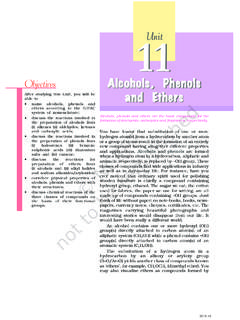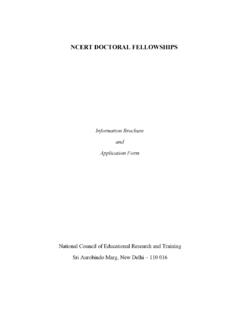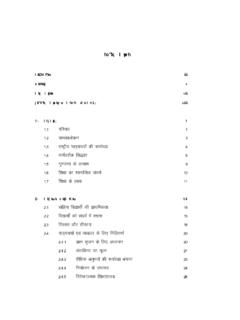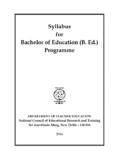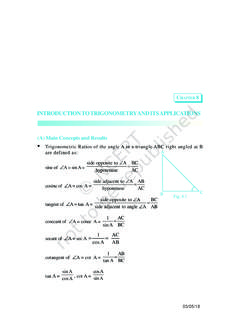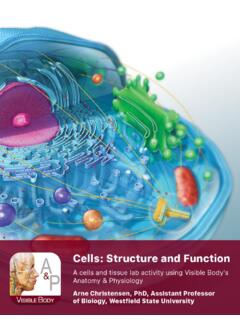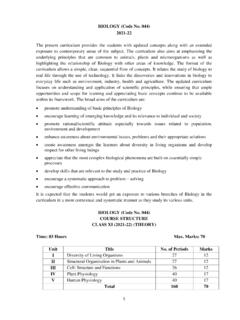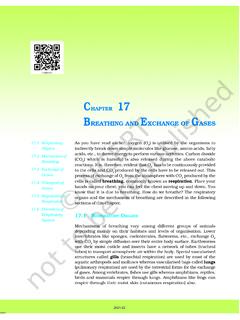Transcription of HAPTER 14 R IN P
1 226 BIOLOGY. C HAPTER 14. respiration IN PLANTS. Do Plants All of us breathe to live, but why is breathing so essential to life? What Breathe? happens when we breathe? Also, do all living organisms, including plants Glycolysis and microbes, breathe? If so, how? All living organisms need energy for carrying out daily life activities, Fermentation be it absorption, transport, movement, reproduction or even breathing. Aerobic Where does all this energy come from? We know we eat food for energy . respiration but how is this energy taken from food? How is this energy utilised? Do all foods give the same amount of energy? Do plants eat'? Where do plants The Respiratory get their energy from?
2 And micro-organisms for their energy Balance Sheet requirements, do they eat food'? Amphibolic You may wonder at the several questions raised above they may Pathway seem to be very disconnected. But in reality, the process of breathing is very much connected to the process of release of energy from food. Let us Respiratory try and understand how this happens. Quotient All the energy required for life' processes is obtained by oxidation of some macromolecules that we call food'. Only green plants and cyanobacteria can prepare their own food; by the process of photosynthesis they trap light energy and convert it into chemical energy that is stored in the bonds of carbohydrates like glucose, sucrose and starch.
3 We must remember that in green plants too, not all cells, tissues and organs photosynthesise; only cells containing chloroplasts, that are most often located in the superficial layers, carry out photosynthesis. Hence, even in green plants all other organs, tissues and cells that are non-green, need food for oxidation. Hence, food has to be translocated to all non- green parts. Animals are heterotrophic, , they obtain food from plants 2021-22. respiration IN PLANTS 227. directly (herbivores) or indirectly (carnivores). Saprophytes like fungi are dependent on dead and decaying matter. What is important to recognise is that ultimately all the food that is respired for life processes comes from photosynthesis.
4 This chapter deals with cellular respiration or the mechanism of breakdown of food materials within the cell to release energy, and the trapping of this energy for synthesis of ATP. Photosynthesis, of course, takes place within the chloroplasts (in the eukaryotes), whereas the breakdown of complex molecules to yield energy takes place in the cytoplasm and in the mitochondria (also only in eukaryotes). The breaking of the C-C bonds of complex compounds through oxidation within the cells, leading to release of considerable amount of energy is called respiration . The compounds that are oxidised during this process are known as respiratory substrates.
5 Usually carbohydrates are oxidised to release energy, but proteins, fats and even organic acids can be used as respiratory substances in some plants, under certain conditions. During oxidation within a cell, all the energy contained in respiratory substrates is not released free into the cell, or in a single step. It is released in a series of slow step-wise reactions controlled by enzymes, and it is trapped as chemical energy in the form of ATP. Hence, it is important to understand that the energy released by oxidation in respiration is not (or rather cannot be) used directly but is used to synthesise ATP, which is broken down whenever (and wherever) energy needs to be utilised.
6 Hence, ATP acts as the energy currency of the cell. This energy trapped in ATP is utilised in various energy-requiring processes of the organisms, and the carbon skeleton produced during respiration is used as precursors for biosynthesis of other molecules in the cell. DO PLANTS BREATHE? Well, the answer to this question is not quite so direct. Yes, plants require O2 for respiration to occur and they also give out CO2. Hence, plants have systems in place that ensure the availability of O2. Plants, unlike animals, have no specialised organs for gaseous exchange but they have stomata and lenticels for this purpose. There are several reasons why plants can get along without respiratory organs.
7 First, each plant part takes care of its own gas-exchange needs. There is very little transport of gases from one plant part to another. Second, plants do not present great demands for gas exchange. Roots, stems and leaves respire at rates far lower than animals do. Only during photosynthesis are large volumes of gases exchanged and, each leaf is well adapted to take care of its own needs during these periods. When cells photosynthesise, availability of O2 is not a problem in these cells since O2 is released within the cell. Third, the 2021-22. 228 BIOLOGY. distance that gases must diffuse even in large, bulky plants is not great. Each living cell in a plant is located quite close to the surface of the plant.
8 This is true for leaves', you may ask, but what about thick, woody stems and roots?' In stems, the living' cells are organised in thin layers inside and beneath the bark. They also have openings called lenticels. The cells in the interior are dead and provide only mechanical support. Thus, most cells of a plant have at least a part of their surface in contact with air. This is also facilitated by the loose packing of parenchyma cells in leaves, stems and roots, which provide an interconnected network of air spaces. The complete combustion of glucose, which produces CO2 and H2O. as end products, yields energy most of which is given out as heat.
9 C6H12O6 + 6O2 6CO2 + 6H2O + Energy If this energy is to be useful to the cell, it should be able to utilise it to synthesise other molecules that the cell requires. The strategy that the plant cell uses is to catabolise the glucose molecule in such a way that not all the liberated energy goes out as heat. The key is to oxidise glucose not in one step but in several small steps enabling some steps to be just large enough such that the energy released can be coupled to ATP. synthesis. How this is done is, essentially, the story of respiration . During the process of respiration , oxygen is utilised, and carbon dioxide, water and energy are released as products.
10 The combustion reaction requires oxygen. But some cells live where oxygen may or may not be available. Can you think of such situations (and organisms) where O2 is not available? There are sufficient reasons to believe that the first cells on this planet lived in an atmosphere that lacked oxygen. Even among present-day living organisms, we know of several that are adapted to anaerobic conditions. Some of these organisms are facultative anaerobes, while in others the requirement for anaerobic condition is obligate. In any case, all living organisms retain the enzymatic machinery to partially oxidise glucose without the help of oxygen. This breakdown of glucose to pyruvic acid is called glycolysis.
